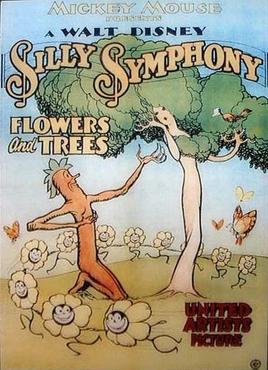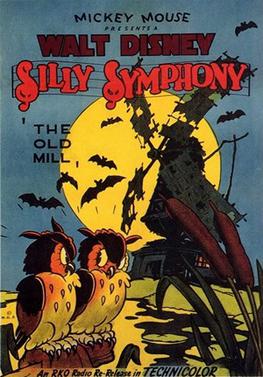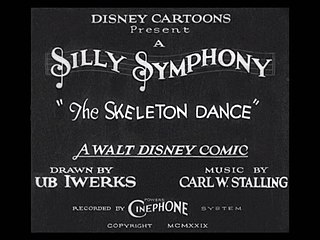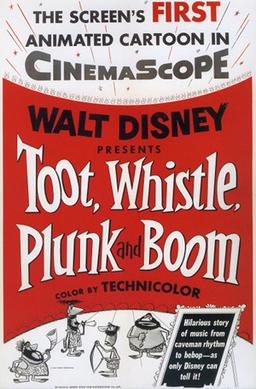Related Research Articles

Snow White and the Seven Dwarfs is a 1937 American animated musical fantasy film produced by Walt Disney Productions and released by RKO Radio Pictures. Based on the 1812 German fairy tale by the Brothers Grimm, the production was supervised by David Hand, and was directed by a team of sequence directors, including Perce Pearce, William Cottrell, Larry Morey, Wilfred Jackson, and Ben Sharpsteen. It is the first animated feature film produced in the United States and the first cel animated feature film.

The Wise Little Hen is a 1934 Walt Disney's Silly Symphony cartoon, based on the fable The Little Red Hen. The cartoon features the debut of Donald Duck, dancing to "The Sailor's Hornpipe". Donald and his friend Peter Pig try to avoid work by faking stomach aches until Mrs. Hen teaches them the value of labor.
Silly Symphony is an American animated series of 75 musical short films produced by Walt Disney Productions from 1929 to 1939. As the series name implies, the Silly Symphonies were originally intended as whimsical accompaniments to pieces of music. As such, the films usually did not feature continuing characters, unlike the Mickey Mouse shorts produced by Disney at the same time. The series is notable for its innovation with Technicolor and the multiplane motion picture camera, as well as its introduction of the character Donald Duck, who made his first appearance in the Silly Symphony cartoon The Wise Little Hen in 1934. Seven shorts won the Academy Award for Best Animated Short Film.

Flowers and Trees is a Silly Symphonies cartoon produced by Walt Disney, directed by Burt Gillett, and released to theatres by United Artists on July 30, 1932. It was the first commercially released film to be produced in the full-color three-strip Technicolor process after several years of two-color Technicolor films. The film was a commercial and critical success, winning the first Academy Award for Best Cartoon Short Subject.

Melody Time is a 1948 American live-action and animated musical anthology film produced by Walt Disney. It was released to theatres by RKO Radio Pictures on May 27, 1948. Made up of seven segments set to popular music and folk music, the film is, like Make Mine Music before it, the popular music version of Fantasia. Melody Time, while not meeting the artistic accomplishments of Fantasia, was mildly successful.

The Old Mill is a Silly Symphonies cartoon produced by Walt Disney Productions, directed by Wilfred Jackson, scored by Leigh Harline, and released theatrically to theatres by RKO Radio Pictures on November 5, 1937. The film depicts the natural community of animals populating an old abandoned windmill in the country, and how they deal with a severe summer thunderstorm that nearly destroys their habitat. It incorporates the song "One Day When We Were Young" from Johann Strauss II's operetta The Gypsy Baron.

The Skeleton Dance is a 1929 Silly Symphony animated short subject with a comedy horror theme. It was produced and directed by Walt Disney and animated by Ub Iwerks. In the film, four human skeletons dance and make music around a spooky graveyard—a modern film example of medieval European "danse macabre" imagery. It is the first entry in the Silly Symphony series. In 1993, to coincide with the opening of Mickey's Toontown in Disneyland, a shortened cover of the cartoon's music was arranged to be featured in the land's background ambiance. The short's copyright was renewed in 1957, and as a published work from 1929 it will enter the US public domain on January 1, 2025.

Babes in the Woods is a 1932 Silly Symphonies animated film.

Three Little Pigs is a 1933 animated short film released by United Artists, produced by Walt Disney and directed by Burt Gillett. Based on the fable of the same name, the Silly Symphony won the 1934 Academy Award for Best Animated Short Film. The short cost $22,000 and grossed $250,000.

Toot, Whistle, Plunk and Boom is an American animated short film produced by Walt Disney Productions and directed by Ward Kimball and Charles A. Nichols. A sequel to the first Adventures in Music cartoon, the 3-D short Melody, Toot, Whistle, Plunk and Boom is a stylized presentation of the evolution of the four orchestra sections over the ages with: the brass ("toot"), the woodwind ("whistle"), the strings ("plunk"), and the percussion ("boom").
The China Shop, based on the fairy tale "The Shepherdess and the Chimney Sweep" by Hans Christian Andersen, is a short animated Disney cartoon, part of the Silly Symphonies series. The cartoon was released on January 13, 1934. The short was directed by Wilfred Jackson.
The Grasshopper and the Ants is a 1934 American animated short film produced by Walt Disney Productions and released by United Artists. Part of the Silly Symphonies series, the film is an adaptation of The Ant and the Grasshopper, one of Aesop's Fables. It was directed by Wilfred Jackson and stars Pinto Colvig as the voice of the grasshopper Hop.

Wynken, Blynken & Nod is a 1938 Silly Symphonies cartoon, adapted from Eugene Field's poem of the same name. Like other Symphonies at the time, it utilized the multiplane camera. It was directed by Graham Heid, produced by Walt Disney Productions, and distributed by RKO Radio Pictures. The three children bore similarities to Michael Darling in the 1953 Disney feature film, Peter Pan.

The Robber Kitten is a 1935 Walt Disney Silly Symphonies cartoon, directed by David Hand.
Springtime is a Silly Symphonies animated Disney short film. It was released in 1929. It was the third Silly Symphonies film to be produced, just five days before the 1929 Stock Market Crash. The short's copyright was renewed in 1957, so it will enter the US public domain on January 1, 2025.
The Busy Beavers is a 1931 Silly Symphonies animated film, directed by Burt Gillett.
Peculiar Penguins is a Silly Symphonies animated short film produced by Walt Disney Productions. It was released in 1934. The song played during the cartoon is called "The Penguin Is a Very Funny Creature", by Leigh Harline.

The Goddess of Spring is a 9-minute Silly Symphonies animated Disney short film. The Symphony is imbued with operatic themes and is often cited as melodramatic. It was released in 1934, and its production was important to the future development of Disney's Snow White and the Seven Dwarfs animation. Each Silly Symphony was a technological marvel at the time and proceeded to further advancements in the animation industry.

Woodland Café is a Silly Symphonies animated Disney short film. It was filmed in Technicolor and released by United Artists in 1937 and was re-issued by RKO Radio Pictures in 1948. While it contained no on-screen credits, Wilfred Jackson was the director and Leigh Harline was the musical director.

Farmyard Symphony is a 1938 Silly Symphonies animated short film. It can be seen as a precursor to Fantasia due to using various pieces of classical music in one short. The film was directed by Jack Cutting and produced by Walt Disney.
References
- 1 2 "The Disney Dream Factory". Austin Chronicle . September 14, 1998. Archived from the original on 11 July 2011. Retrieved 8 June 2010.
- 1 2 Marcus, Kenneth H (2004). Musical Metropolis: Los Angeles and the Creation of a Music Culture, 1880-1940 (illustrated ed.). Macmillan. p. 182. ISBN 1-4039-6419-X. Archived from the original on 2023-10-23. Retrieved June 8, 2010– via Google Books.
- ↑ Dinerstein, Joel (2003). Swinging the Machine: Modernity, Technology, and African American Culture Between the World Wars (illustrated ed.). University of Massachusetts Press. pp. 54–55. ISBN 1-55849-383-2. Archived from the original on 2023-10-23. Retrieved 2021-03-31– via Google Books.
- ↑ BWW Newsdesk (April 27, 2010). "AMPAS Hosts 'What's Opera, Doc? Animation and Classical Music". Broadway World. Archived from the original on 30 April 2010. Retrieved 9 June 2010.
- 1 2 "What's Opera, Doc? – Animation and Classical Music". Academy of Motion Picture Arts and Sciences. Archived from the original on 2 May 2010. Retrieved 9 June 2010.
- ↑ Sadoul, Georges; Morris, Peter (1972). Peter Morris (ed.). Dictionary of films (illustrated ed.). University of California Press. p. 342. ISBN 0-520-02152-5. Archived from the original on 2023-10-23. Retrieved 2021-03-31– via Google Books.
- ↑ "Silly Symphonies: The Historic Musical Animated Classics DVD Review". DVDizzy.com. Archived from the original on 25 February 2021. Retrieved 20 February 2021.
- ↑ "Snow White and the Seven Dwarfs: Diamond Edition Blu-ray Review - Page 2 of 2". DVDizzy.com.